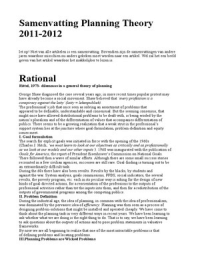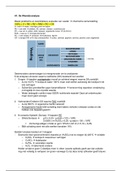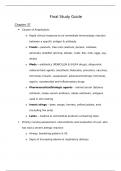Samenvatting Planning Theory
2011-2012
let op! Niet van alle artikelen is een samenvatting. Bovendien zijn de samenvattingen van andere
jaren waardoor misschien nu anders gekeken moet worden naar een artikel. Wel zal het een beeld
geven van het artikel waardoor het makkelijker te lezen is.
Rational
Rittel, 1973- dilemmas in a general theory of planning
George Shaw diagnosed the case several years ago; in more recent times popular protest may
have already become a social movement. Shaw believed that ‘every profession is a
conspiracy against the laity’ (laity = lekenpubliek).
The professional’s job that once seen as solving an assortment of problems that
appeared to be definable, understandable and consensual. But the seeming consensus, that
might once have allowed distributional problems to be dealt with, is being eroded by the
nation’s pluralism and of the differentiation of values that accompanies differentiation of
publics. There seems to be a growing realization that a weak strut in the professional’s
support system lies at the juncture where goal-formulation, problem-definition and equity
issues meet.
I. Goal formulation
The search for explicit goals was initiated in force with the opening of the 1960s
(Charles J. Hitch; ‘we must learn to look at our objectives as critically and as professionally
as we look at our models and our other inputs’). 1960 was inaugurated with the publication of
Goals for America, the report of President Eisenhower’s Commission on National Goals.
There followed then a wave of similar efforts. Although there are some small success stories
recounted in a few civilian agencies, successes are still rare. Goal-finding is turning out to be
an extraordinarily difficult task.
During the 60s there have also been revolts. Revolts by the blacks, by students and
against the war. System analysis, goals commissions, PPBS, social indicators, the several
revolts, the poverty program, etc. each in its peculiar way is asking for the design of new
kinds of goal-directed actions, for a reorientation of the professions to the outputs of
professional activities rather than tot the inputs into them, and then for a redistribution of the
outputs of governmental programs among the competing publics.
II. Problem Definition
During the industrial age, the idea of planning, in common with the idea of professionalism,
was dominated by the pervasive idea of efficiency. Planning was then seen as a process of
designing problem-solutions that might be installed and operated cheaply. We have come to
think about the planning task in very different ways in recent years. We have been learning to
ask whether what we are doing is the right thing to do. That is to say, we have been learning
to ask questions about the outputs of actions and to pose problem statements in valuative
frameworks.
By now we are all beginning to realize that one of the most intractable problems is that
of defining problems and locating problems.
III.Planning Problems are Wicked Problems
,Theory is inadequate for decent forecasting, our intelligence is insufficient to our tasks,
plurality of objectives held by pluralities of politics makes it impossible to pursue unitary
aims, etc. All these are barriers that keep us from perfecting planning/governing system.
This is partly because of the paradigm of science and engineering.
79
Stuvia.com - De Marktplaats voor het Kopen en Verkopen van je Studiemateriaal
The societal problems that planners deal with are very different from the problems that
scientist and engineers deal with. Planning problems are inherently wicked. These problems
cannot be solved like problems in natural sciences; they have no clarifying traits.
There are at least ten distinguishing properties of planning-type problems:
1. There is no definitive formulation of a wicked problem
The information needed to understand the problem depends upon one’s idea for
solving it; in order to describe a wicked-problem in sufficient detail, one has to
develop an exhaustive inventory of all conceivable solutions ahead of time. The
formulation of the wicked problem is the problem.
2. Wicked problems have no stopping rule
In solving a chess problem or a mathematical one, the problem-solver knows when
he has done his job. Not so with planning problems. You can only say ‘This is the
best I can do within time/budget’ for example.
3. Solutions to wicked problems are not true-or-false, but good-or-bad
4. There is no immediate and no ultimate test of a solution to a wicked problem
For tame-problems one can determine on the spot how good a solution-attempt has
been. With wicked problems, on the other hand, any solution will generate waves
of consequences over an extended period of time.
5. Every solution to a wicked problem is a “one-shot operation”; because there is no
opportunity to learn by trial-and-error, every attempt counts significantly
6. Wicked problems do not have an enumerable (or an exhaustively describable) set
of potential solutions, nor is there a well-described set of permissible operations
that may be incorporated into the plan.
There are no criteria which enable one to prove that all solutions to a wicked
problem have been identified and considered.
7. Every wicked problem is essentially unique
Despite a long list of similarities between a current problem and a precious one,
there always might be an additional distinguishing property that is of overriding
importance.
8. Every wicked problem can be considered to be a symptom of another problem
9. The existence of a discrepancy representing a wicked problem can be explained
in numerous ways. The choice of explanation determines the nature of the
problem’s resolution
10. The planner has not right to be wrong
Planners are liable for the consequences of the actions they generate; the effects
can matter a great deal to those people that are touched by those actions.
IV. The Social Context
The high-scale societies of the western world are becoming increasingly heterogeneous. In a
setting in which a plurality of publics is politically pursuing a diversity of goals, how is the
larger society to deal with its wicked problems in a planful way?
One traditional approach to the reconciliation of social values and individual choice is
to entrust de facto decision-making to the wise and knowledgeable professional experts and
politicians. But whether one finds that ethically tolerable or not, even such a tactic only begs
the question, for there are no value-free, true-false answers to any of the wicked problems
governments must deal with.
, Baum, 1997- toward a post-industrial planning theory
Towards a post-industrial planning theory (1977)
Introductie
Sinds de jaren 60-70 komt op alle fronten het post-industrialisme op. Zo ook in de planning.
Rationalisme verliest zijn waarde en maakt plaats voor zelfbewust denken en ervaren.
A concept of post-industrialism and some evidence
Enkele gemeenschappelijke trends zijn in het post-industrialisme aanwijsbaar: het
spanningsveld tussen het verdwijnen van traditionele concepten en het reconstrueren van
concepten, evenals het spanningsveld tussen rationalisme en existentialisme (extern ‘
geordend’ of intern ‘geordend‘ ). Voor planners betekent dit dat de nadruk nog eens extra
komt te liggen op analyse en synthese. In de praktijk leidt dit bijvoorbeeld tot de groei van de
tertiaire sector. Statistische veranderingen als deze zijn alleen interessant als zij een illustratie
zijn van een kwalitatieve vooruitgang. Over het algemeen geldt (in 1977): meer mensen in
bureaucratische organisaties, minder mensen in primaire sector, grotere vraag naar
intelligentie en planning, omdat er meer mensen betrokken zijn, waardoor de complexiteit
groter wordt. Planners maken deel uit van de whitecollar component van de samenleving en
moeten culturele kennis toepassen op het reageren op veranderende sociale constructies.
Rationalism
Rationalisme is eigenlijk drieledig. Allereerst gaat het erom hoe je de wereld ervaart, namelijk
rationeel, doordacht, zonder ruimte voor emotie. Ten tweede omvat het een manier van de
wereld begrijpen, namelijk door het te analyseren (met wetenschap als instrument) en het
onder te verdelen in kleine stukjes. Ten derde biedt het een manier/methode om oplossingen
te construeren. Namelijk oplossingen voor kleine stukjes problemen die samen een grote
oplossing vormen, waarbij de oplossing die het meeste oplevert en de minste kosten brengt,
de beste oplossing is. Efficiëntie is van groot belang.
Ook bij de gewone mens zijn het in de jaren 60-80 deze concepten die overwegend de
boventoon voeren.
Rational planning theory and its consequences
Twee consequenties van rationeel denken staan het succes van rationeel plannen in de weg.
De eerste is het analytische vooroordeel. Door problemen op te delen in kleine stukjes verliest
men dwarsverbanden uit het zicht en komt er geen integrale oplossing voor een probleem. Het
gaat voorbij aan het pakket van behoeften dat integraal onderdeel van een individu of groep
en niet los van elkaar is te zien, terwijl rationalistisch denken juist de nadruk legt op het
uitsplitsen van die behoeften. De tweede consequentie is het vooroordeel over efficiëntie.
Deze is tweeledig; allereerst wordt er uitsluitend gekeken naar de kosten-batenverhouding om
te bepalen of iets efficiënt is. Dit is op zich nog niet zo’n probleem, maar daar komt bij dat
aan alle kleine stukjes analyse een kwantitatieve waarde moet kunnen worden toegekend:
geldwaarde. Daarmee wordt voorbijgegaan en niet-materiële en persoonlijke waarden en
wordt ons geleerd mensen te ‘meten’ als iets niet-menselijks. Daarnaast is deze opvatting
fundamenteel conservatief in dat het bestaande structuren alleen maar versterkt (een arbeider
is economisch minder waard dan een notabele en daar wordt naar gehandeld) en weinig
ruimte biedt voor nieuwe ideologieën
Bureaucracy and planners
Inherent aan rationalisme is bureaucratie binnen organisaties, doordat alles wordt opgedeeld
in kleine partjes. Bureaucratie heeft als basis dat het grote delen zou moeten maken bij wijze
van vereniging van alle kleine stukjes. Ook hierbij worden centrale doelen nogal eens
2011-2012
let op! Niet van alle artikelen is een samenvatting. Bovendien zijn de samenvattingen van andere
jaren waardoor misschien nu anders gekeken moet worden naar een artikel. Wel zal het een beeld
geven van het artikel waardoor het makkelijker te lezen is.
Rational
Rittel, 1973- dilemmas in a general theory of planning
George Shaw diagnosed the case several years ago; in more recent times popular protest may
have already become a social movement. Shaw believed that ‘every profession is a
conspiracy against the laity’ (laity = lekenpubliek).
The professional’s job that once seen as solving an assortment of problems that
appeared to be definable, understandable and consensual. But the seeming consensus, that
might once have allowed distributional problems to be dealt with, is being eroded by the
nation’s pluralism and of the differentiation of values that accompanies differentiation of
publics. There seems to be a growing realization that a weak strut in the professional’s
support system lies at the juncture where goal-formulation, problem-definition and equity
issues meet.
I. Goal formulation
The search for explicit goals was initiated in force with the opening of the 1960s
(Charles J. Hitch; ‘we must learn to look at our objectives as critically and as professionally
as we look at our models and our other inputs’). 1960 was inaugurated with the publication of
Goals for America, the report of President Eisenhower’s Commission on National Goals.
There followed then a wave of similar efforts. Although there are some small success stories
recounted in a few civilian agencies, successes are still rare. Goal-finding is turning out to be
an extraordinarily difficult task.
During the 60s there have also been revolts. Revolts by the blacks, by students and
against the war. System analysis, goals commissions, PPBS, social indicators, the several
revolts, the poverty program, etc. each in its peculiar way is asking for the design of new
kinds of goal-directed actions, for a reorientation of the professions to the outputs of
professional activities rather than tot the inputs into them, and then for a redistribution of the
outputs of governmental programs among the competing publics.
II. Problem Definition
During the industrial age, the idea of planning, in common with the idea of professionalism,
was dominated by the pervasive idea of efficiency. Planning was then seen as a process of
designing problem-solutions that might be installed and operated cheaply. We have come to
think about the planning task in very different ways in recent years. We have been learning to
ask whether what we are doing is the right thing to do. That is to say, we have been learning
to ask questions about the outputs of actions and to pose problem statements in valuative
frameworks.
By now we are all beginning to realize that one of the most intractable problems is that
of defining problems and locating problems.
III.Planning Problems are Wicked Problems
,Theory is inadequate for decent forecasting, our intelligence is insufficient to our tasks,
plurality of objectives held by pluralities of politics makes it impossible to pursue unitary
aims, etc. All these are barriers that keep us from perfecting planning/governing system.
This is partly because of the paradigm of science and engineering.
79
Stuvia.com - De Marktplaats voor het Kopen en Verkopen van je Studiemateriaal
The societal problems that planners deal with are very different from the problems that
scientist and engineers deal with. Planning problems are inherently wicked. These problems
cannot be solved like problems in natural sciences; they have no clarifying traits.
There are at least ten distinguishing properties of planning-type problems:
1. There is no definitive formulation of a wicked problem
The information needed to understand the problem depends upon one’s idea for
solving it; in order to describe a wicked-problem in sufficient detail, one has to
develop an exhaustive inventory of all conceivable solutions ahead of time. The
formulation of the wicked problem is the problem.
2. Wicked problems have no stopping rule
In solving a chess problem or a mathematical one, the problem-solver knows when
he has done his job. Not so with planning problems. You can only say ‘This is the
best I can do within time/budget’ for example.
3. Solutions to wicked problems are not true-or-false, but good-or-bad
4. There is no immediate and no ultimate test of a solution to a wicked problem
For tame-problems one can determine on the spot how good a solution-attempt has
been. With wicked problems, on the other hand, any solution will generate waves
of consequences over an extended period of time.
5. Every solution to a wicked problem is a “one-shot operation”; because there is no
opportunity to learn by trial-and-error, every attempt counts significantly
6. Wicked problems do not have an enumerable (or an exhaustively describable) set
of potential solutions, nor is there a well-described set of permissible operations
that may be incorporated into the plan.
There are no criteria which enable one to prove that all solutions to a wicked
problem have been identified and considered.
7. Every wicked problem is essentially unique
Despite a long list of similarities between a current problem and a precious one,
there always might be an additional distinguishing property that is of overriding
importance.
8. Every wicked problem can be considered to be a symptom of another problem
9. The existence of a discrepancy representing a wicked problem can be explained
in numerous ways. The choice of explanation determines the nature of the
problem’s resolution
10. The planner has not right to be wrong
Planners are liable for the consequences of the actions they generate; the effects
can matter a great deal to those people that are touched by those actions.
IV. The Social Context
The high-scale societies of the western world are becoming increasingly heterogeneous. In a
setting in which a plurality of publics is politically pursuing a diversity of goals, how is the
larger society to deal with its wicked problems in a planful way?
One traditional approach to the reconciliation of social values and individual choice is
to entrust de facto decision-making to the wise and knowledgeable professional experts and
politicians. But whether one finds that ethically tolerable or not, even such a tactic only begs
the question, for there are no value-free, true-false answers to any of the wicked problems
governments must deal with.
, Baum, 1997- toward a post-industrial planning theory
Towards a post-industrial planning theory (1977)
Introductie
Sinds de jaren 60-70 komt op alle fronten het post-industrialisme op. Zo ook in de planning.
Rationalisme verliest zijn waarde en maakt plaats voor zelfbewust denken en ervaren.
A concept of post-industrialism and some evidence
Enkele gemeenschappelijke trends zijn in het post-industrialisme aanwijsbaar: het
spanningsveld tussen het verdwijnen van traditionele concepten en het reconstrueren van
concepten, evenals het spanningsveld tussen rationalisme en existentialisme (extern ‘
geordend’ of intern ‘geordend‘ ). Voor planners betekent dit dat de nadruk nog eens extra
komt te liggen op analyse en synthese. In de praktijk leidt dit bijvoorbeeld tot de groei van de
tertiaire sector. Statistische veranderingen als deze zijn alleen interessant als zij een illustratie
zijn van een kwalitatieve vooruitgang. Over het algemeen geldt (in 1977): meer mensen in
bureaucratische organisaties, minder mensen in primaire sector, grotere vraag naar
intelligentie en planning, omdat er meer mensen betrokken zijn, waardoor de complexiteit
groter wordt. Planners maken deel uit van de whitecollar component van de samenleving en
moeten culturele kennis toepassen op het reageren op veranderende sociale constructies.
Rationalism
Rationalisme is eigenlijk drieledig. Allereerst gaat het erom hoe je de wereld ervaart, namelijk
rationeel, doordacht, zonder ruimte voor emotie. Ten tweede omvat het een manier van de
wereld begrijpen, namelijk door het te analyseren (met wetenschap als instrument) en het
onder te verdelen in kleine stukjes. Ten derde biedt het een manier/methode om oplossingen
te construeren. Namelijk oplossingen voor kleine stukjes problemen die samen een grote
oplossing vormen, waarbij de oplossing die het meeste oplevert en de minste kosten brengt,
de beste oplossing is. Efficiëntie is van groot belang.
Ook bij de gewone mens zijn het in de jaren 60-80 deze concepten die overwegend de
boventoon voeren.
Rational planning theory and its consequences
Twee consequenties van rationeel denken staan het succes van rationeel plannen in de weg.
De eerste is het analytische vooroordeel. Door problemen op te delen in kleine stukjes verliest
men dwarsverbanden uit het zicht en komt er geen integrale oplossing voor een probleem. Het
gaat voorbij aan het pakket van behoeften dat integraal onderdeel van een individu of groep
en niet los van elkaar is te zien, terwijl rationalistisch denken juist de nadruk legt op het
uitsplitsen van die behoeften. De tweede consequentie is het vooroordeel over efficiëntie.
Deze is tweeledig; allereerst wordt er uitsluitend gekeken naar de kosten-batenverhouding om
te bepalen of iets efficiënt is. Dit is op zich nog niet zo’n probleem, maar daar komt bij dat
aan alle kleine stukjes analyse een kwantitatieve waarde moet kunnen worden toegekend:
geldwaarde. Daarmee wordt voorbijgegaan en niet-materiële en persoonlijke waarden en
wordt ons geleerd mensen te ‘meten’ als iets niet-menselijks. Daarnaast is deze opvatting
fundamenteel conservatief in dat het bestaande structuren alleen maar versterkt (een arbeider
is economisch minder waard dan een notabele en daar wordt naar gehandeld) en weinig
ruimte biedt voor nieuwe ideologieën
Bureaucracy and planners
Inherent aan rationalisme is bureaucratie binnen organisaties, doordat alles wordt opgedeeld
in kleine partjes. Bureaucratie heeft als basis dat het grote delen zou moeten maken bij wijze
van vereniging van alle kleine stukjes. Ook hierbij worden centrale doelen nogal eens











